Coronavirus Today: How this Memorial Day will look ‘so different’ from last
- Share via
Good evening. I’m Karen Kaplan, and it’s Friday, May 28. Due to the Memorial Day holiday, we’ll be off Monday and will return your inbox on Tuesday. Now, here’s the latest on what’s happening with the coronavirus, plus ways to spend your long weekend and a look at some of the week’s best stories.
What a difference a year makes.
Twelve months ago, Memorial Day arrived in California as the state’s first stay-at-home restrictions were lifting and wide swaths of the state were reopening. Residents celebrated their newfound freedom by heading to the beach and around backyard barbecues, mingling with people from other households.
That holiday weekend helped plant the seeds for what eventually would grow into the state’s 2020 summertime surge. Infections, hospitalizations and deaths climbed to then-unprecedented heights, prompting officials to reimpose sweeping restrictions in hopes of blunting the pandemic’s swell.
This Memorial Day finds California once again on the downhill side of a coronavirus curve. But instead of anxiety and fear, there is now hope, my colleague Luke Money reports.
“We’re all so glad that this Memorial Day will look so different from last Memorial Day,” said Los Angeles County Public Health Director Barbara Ferrer. “It’s a relief for so many of us that we’ll be able to gather with family and friends again.”
This holiday will be the first in a long time to resemble a pre-pandemic normal.
Beaches and trails are open. Crowds can again flock to the state’s amusement parks, or enjoy a meal inside an air-conditioned restaurant. Throngs of baseball fans are being welcomed back at Dodger and Angel stadiums.
The state’s strictest limitations on private gatherings have also been lifted, though officials stress that outdoor settings remain safer than indoor ones, and that those who are not yet vaccinated against COVID-19 should still exercise caution.
The biggest difference between this year and last is undoubtedly the availability of COVID-19 vaccines, which are showing tremendous power not just in staving off the worst health impacts of the disease, but also in stymying transmission of the coronavirus.
Over the last week, the state has reported an average of 1,655 new coronavirus cases per day, according to data compiled by The Times. Figures from the U.S. Centers for Disease Control and Prevention show that California continues to log the lowest case rate of any state.
The state’s hospital system, once slammed with an overwhelming deluge of patients, is now caring for fewer coronavirus-positive people than at virtually any point in the entire pandemic.
Many credit California’s vaccine rollout with helping beat back COVID-19. It has given officials more confidence that the state will avert a fourth surge.
But none of that means Californians can afford to let their guards down completely. Gov. Gavin Newsom reminded Californians to continue taking common-sense measures to protect themselves, their friends and their loved ones.
“This disease has not gone away,” he said. “It’s not taking Memorial Day weekend off.”
By the numbers
California cases, deaths and vaccinations as of 1:50 p.m. Friday:

A note on this week’s case counts: On Thursday, L.A. County reported a backlog of nearly 4,000 historic cases from past months. This is a one-time increase that does not reflect a surge in new transmission, officials said. You can find more context in our main coronavirus tracker.
Track California’s coronavirus spread and vaccination efforts — including the latest numbers and how they break down — with our graphics.

See the current status of California’s reopening, county by county, with our tracker.


What to read this weekend
A smartphone tree
Officials rely on the internet to convey public health information about the pandemic, but that’s of little use to older members of the Bay Area’s Laotian immigrant community. Luckily for them, there are phone trees to bring them the information they need.
These elaborate networks are a way to re-create the village networks of Laos in California’s sprawling suburbs. They’re especially important because there are not enough Lao speakers for government agencies to translate their fliers into the language, as is often done for speakers of Spanish, Chinese, Vietnamese and Korean. Nor is the community large enough to support newspapers or television news programs in Lao, leaving monolingual immigrants especially isolated.
When Californians 65 and older became eligible for COVID-19 vaccinations, Torm Normpraseurt of Richmond picked up the phone and called one Laotian immigrant after another. Here’s how to make an appointment, he told them. Someone will find you a ride, and volunteers fluent in both Lao and English will be by your side when you get your shot, he assured.
Normpraseurt was one part of a phone tree that reached households across the Bay Area. The old-school network is so efficient that information often whips through its many branches in less than an hour. Please read this fascinating story by my colleague Anh Do about an unheralded source of lifesaving public health information during the pandemic.
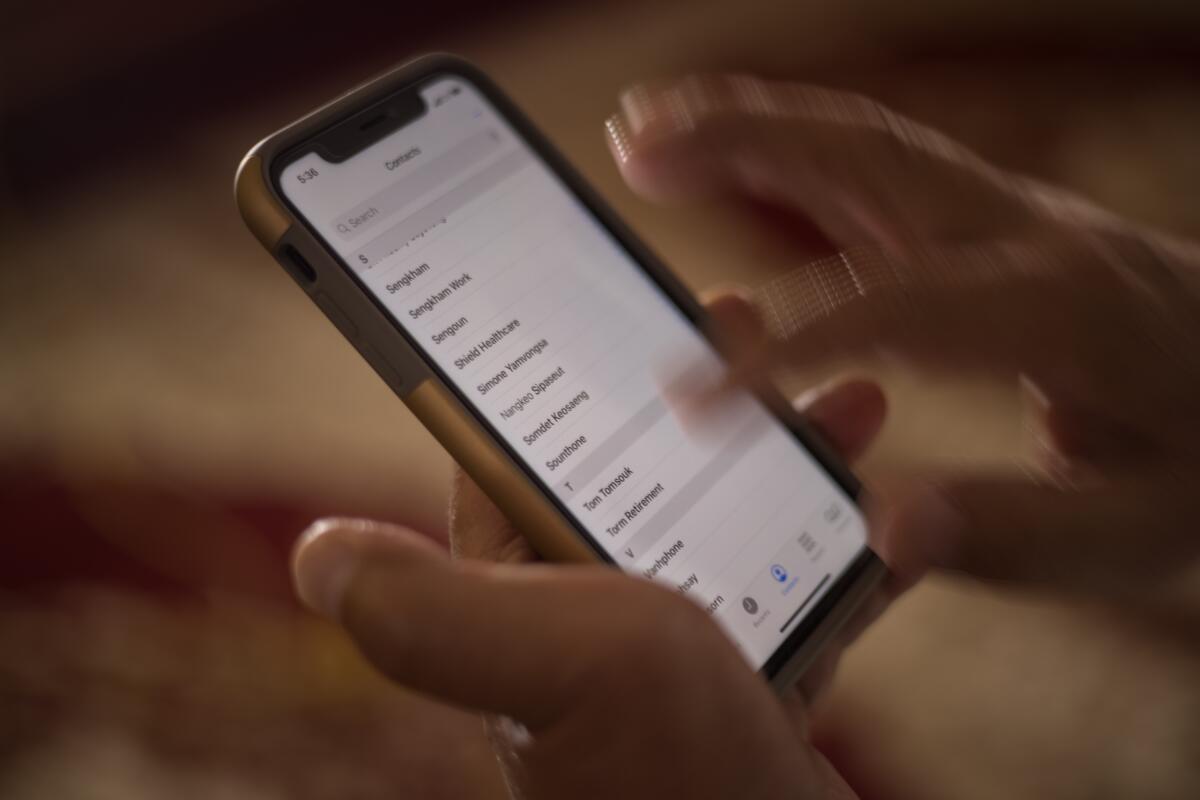
Converting COVID-19 vaccine holdouts
For months, columnist Erika D. Smith has been writing about California’s fervent, but mostly failed, efforts to distribute COVID-19 vaccines equitably. Though vaccines are plentiful, disparities remain — especially in Los Angeles County, where only 34% of Black residents and 42% of Latino residents ages 16 to 64 have received at least one dose, compared with 67% of Asian American and 57% of white residents.
Smith admits that she can almost relate to the readers who fill her inbox with messages saying the vaccines are now easy to get and that those who haven’t yet done so have no one to blame but themselves. So she set out to answer three questions: Who are these holdouts? Why are they holding out? And most importantly, what will get them to stop holding out?
To get answers, Smith joined three canvassers with Community Coalition as they knocked on doors in a working-class neighborhood of well-kept homes in Gardena. The canvassers were on a mission to find COVID-19 vaccine holdouts and ask them what it would take to get them to come around. Their answers may surprise you, but even if they don’t, this column will give you a new appreciation for the people who are so passionate about helping their community.
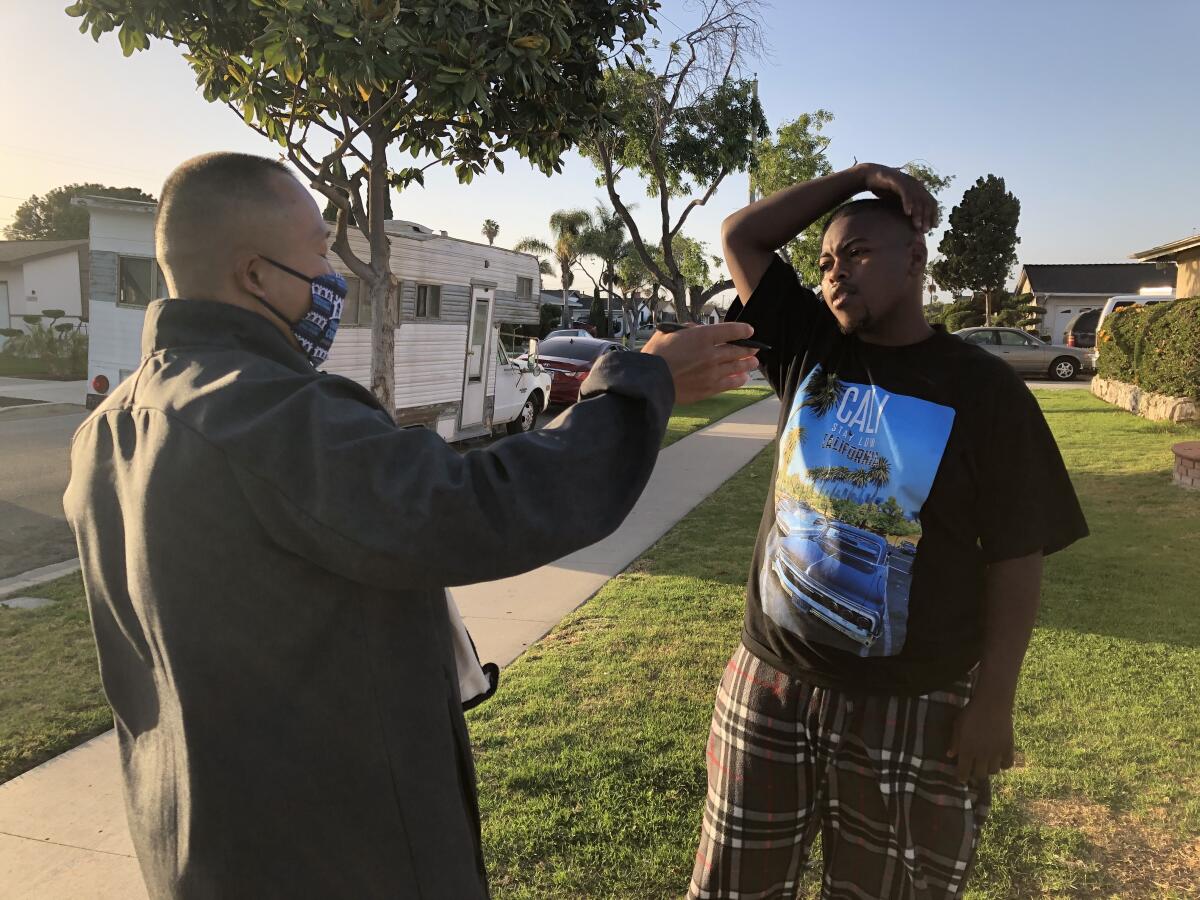
What went wrong in Orange County
The coronavirus has infected more than 254,000 people and killed over 5,000 in Orange County alone. A report from the Orange County Grand Jury provides insight into how the outbreak there took the toll it did.
The grand jury’s investigation revealed that for years, county officials had largely underestimated the threat of a global pandemic — classifying it as likely as a disaster at the San Onofre nuclear plant or an act of terrorism. That mindset resulted in a response that stymied outreach efforts to hard-hit communities and hindered access to testing and vaccines, according to the report.
Plenty of other jurisdictions across California and the U.S. also struggled with their pandemic response. But Orange County stands out because of the distinct role some of its politicians and residents played in fighting back against tough restrictions meant to slow the spread of the coronavirus, my colleague Hannah Fry reports.
If problems aren’t addressed locally now, future pandemics will pose significant challenges, the grand jury warned.

An unwelcome wedding present?
House Minority Leader Kevin McCarthy (R-Bakersfield) has already taken flak for attending his son’s maskless wedding ceremony and reception in early December amid a surge of COVID-19 cases in California. When the San Luis Obispo County nuptials came to light a couple of months later, the congressman contended that he had taken “every precaution” — even though state rules at the time required masks at weddings and banned receptions altogether.
What McCarthy did not disclose was that he subsequently tested positive for antibodies to the coronavirus, my colleague Paul Pringle reports. That’s a sign that he could have been infectious but asymptomatic as he mingled with family members and other guests, experts say. It could also mean he may have contracted the coronavirus at the wedding, or that he was infected long before the event and thus was no longer at risk of spreading it to others.
Either way, the fact that McCarthy had no idea he had been previously infected with the coronavirus underscores the importance of following health orders and guidelines aimed at curbing the spread of the virus. “It’s always helpful and supportive of public health guidance when those in elected positions try to emulate and follow the guidance that the constituents are being asked to abide by,” said Dr. Robert Kim-Farley, medical epidemiologist and infectious disease expert at the UCLA Fielding School of Public Health.
The Las Vegas buffet returns
When it comes to eating, so much of the last year and a half has revolved around survival and attaining the bare minimum. Go grocery shopping once every two weeks and make it count. Grow scallions on your window sill. Bake bread with those rotting bananas. Be sustainable. Thou shalt not waste. Don’t touch anything anyone else has ever touched, ever, without sanitizing. Don’t get too close.
A Las Vegas buffet takes most of those mantras and turns them on their heads. Food columnist Jenn Harris ventured to Sin City to experience the Caesars Palace Bacchanal Buffet American when it opened last week and filed this story, which feels like a dispatch from the post-pandemic future.
People lined up at the carving station, waiting for a sliver of Wagyu, a hunk of prime rib and a slice of brisket. They scooped up individually plated, split rods of bone marrow waiting to be slurped. The space between the guests was less than six feet. Nearby, mountains of crushed ice were sheathed in dozens of pounds of stacked crab legs, shrimp, oysters and scallops on the half shell, lobster claws and snow crab.
But there were a few signs of the times, including sanitizer dispensers between food stations and masks on some of the chefs, who worked behind sneeze guards.
“After the Strip was shut down, a lot of people were saying that buffets would never come back,” said Caesars Palace executive chef Jennifer Murphy. “And as you can see, we’re back and bigger and better than ever.”
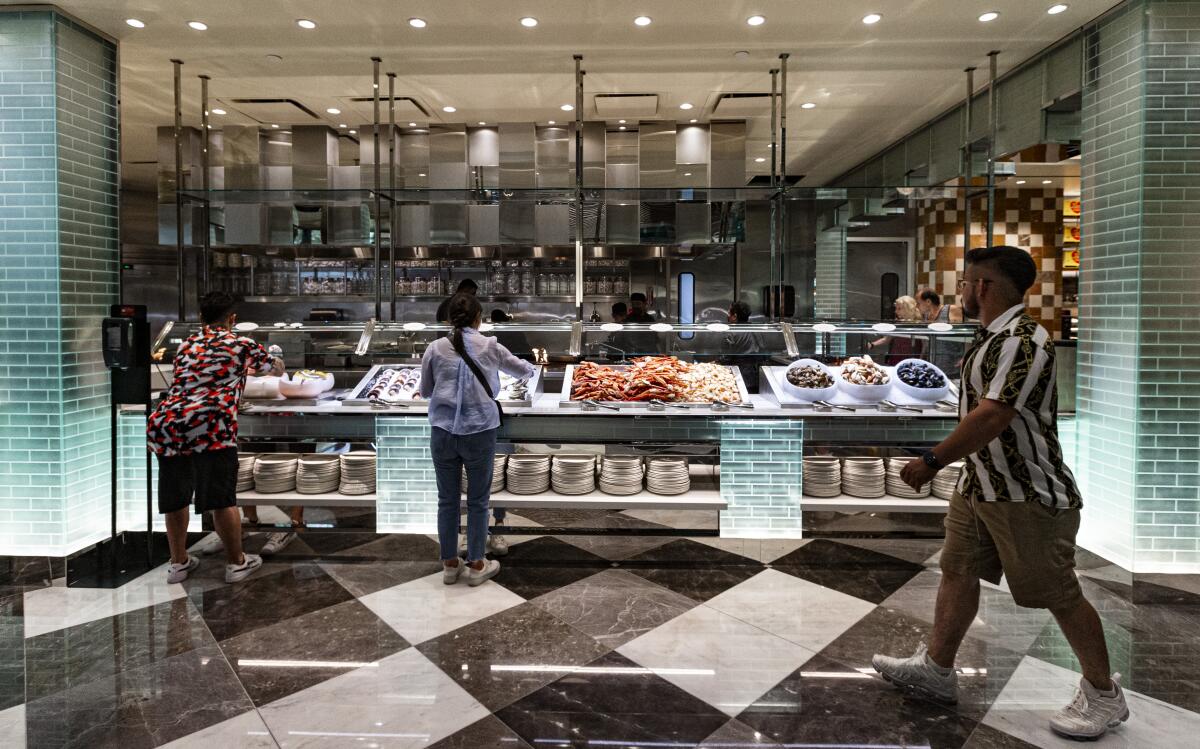
Your support helps us deliver the news that matters most.
What to do this weekend
Get outside. You could start making a dent in our list of California’s 40 best outdoor experiences, or our list of the places readers were outraged we left off. Staying in the city? Try kayaking on the L.A. River once the season opens Memorial Day — or if you’re bringing your dog, these are the 12 best dog-friendly hikes in L.A. Subscribe to the Wild for more on the outdoors.
Get out of town. We’ve got some ideas for last-minute long-weekend SoCal trips. Want to venture a bit farther north? Visit exotic plants in Montecito or head up to the newly reopened Monterey Bay Aquarium, or try another one of our Escapes newsletter’s suggestions.
Watch something great. Consult The Times’ new guide to the 20 TV shows worth staying inside to watch this summer. Our weekend culture roundup includes plenty of virtual events plus some in-person ones, like a free “dance playground” in downtown L.A. And in his Indie Focus newsletter, Mark Olsen looks at three new movies out this week, including “Cruella,” a live-action, ‘70s punk-tinged tale of a fashion designer who would become the Dalmatian-skinning Disney villain.
Eat something great. The L.A. Times Food Bowl, our monthlong food festival, returns next month with events and panel discussions celebrating the best in L.A. dining; you can RSVP and buy tickets here. To get in the spirit of celebrating the city’s food scene, here are our favorite places to eat outside right now. If you’re staying in, whip up one of these 11 easy pasta classics.
Go online. Here’s The Times’ guide to the internet for when you’re looking for information on self-care, feel like learning something new or interesting, or want to expand your entertainment horizons.
The pandemic in pictures
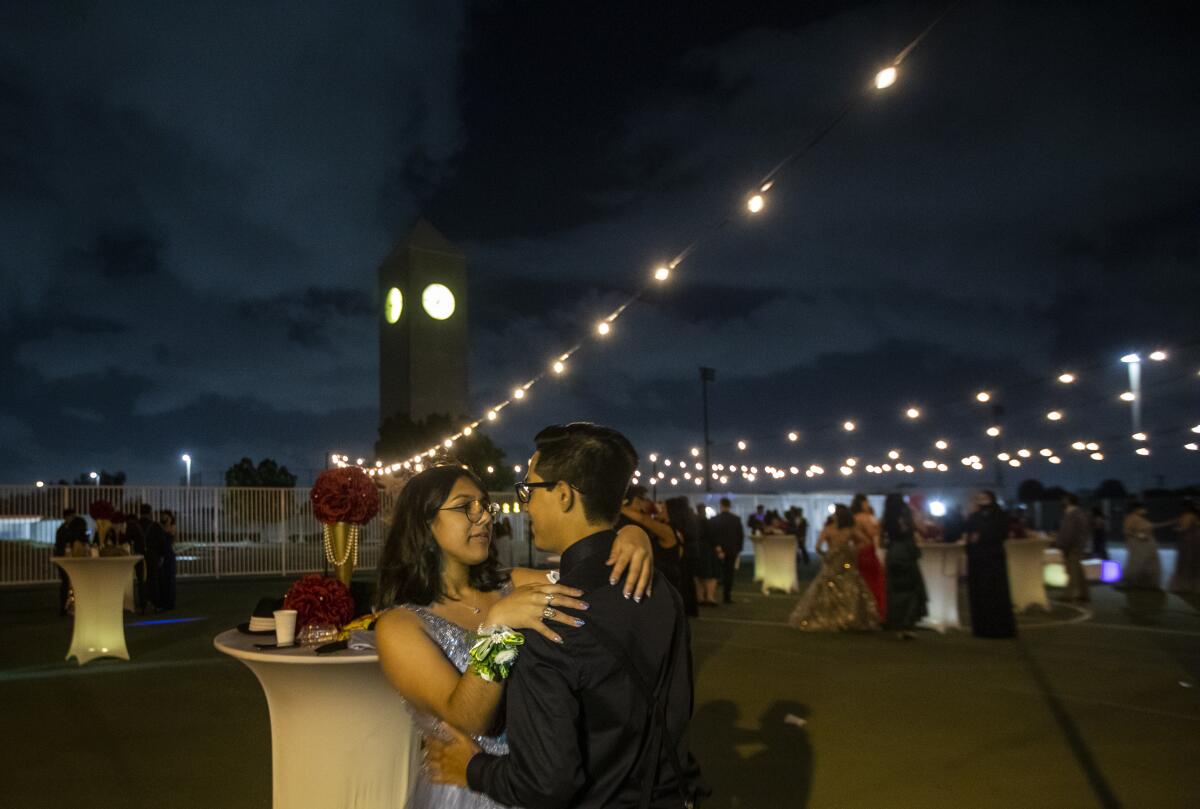
The coronavirus threat in Southern California eased just in time for some high schools to pull together last-minute pandemic proms.
These were not traditional ballroom affairs with shared food and cheek-to-cheek slow dances. In many school districts, masks were required, tables and seating were spaced out, and dancers had to remain at least six feet apart. And in addition to buying tickets, attendees needed to show proof of vaccination or a recent negative COVID-19 test.
Students at Lynwood High School were quite vocal about their desire to salvage their school year with an in-person prom. With the help of staff, they organized a dance in a matter of weeks — using props and decorations from the 2020 prom that never happened.
The dance was held last Friday on the school’s futsal court, with about 140 students in attendance. It was the first gathering of the Class of 2021 in more than a year.
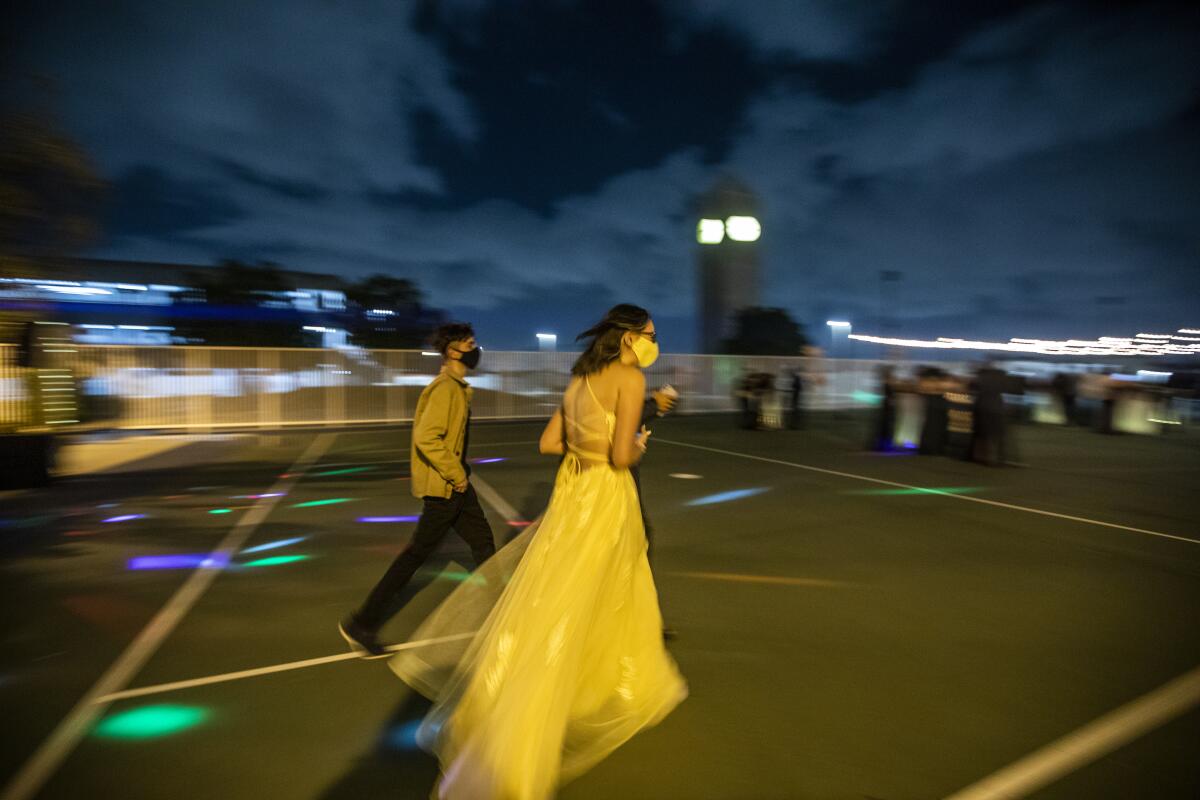
Resources
Need a vaccine? Sign up for email updates, and make an appointment where you live: City of Los Angeles | Los Angeles County | Kern County | Orange County | Riverside County | San Bernardino County | San Diego County | San Luis Obispo County | Santa Barbara County | Ventura County
Need more vaccine help? Talk to your healthcare provider. Call the state’s COVID-19 hotline at (833) 422-4255. And consult our county-by-county guides to getting vaccinated.
Practice social distancing using these tips, and wear a mask or two.
Watch for symptoms such as fever, cough, shortness of breath, chills, shaking with chills, muscle pain, headache, sore throat and loss of taste or smell. Here’s what to look for and when.
Need to get tested? Here’s where you can in L.A. County and around California.
Americans are hurting in many ways. We have advice for helping kids cope, resources for people experiencing domestic abuse and a newsletter to help you make ends meet.
We’ve answered hundreds of readers’ questions. Explore them in our archive here.
For our most up-to-date coverage, visit our homepage and our Health section, get our breaking news alerts, and follow us on Twitter and Instagram.




